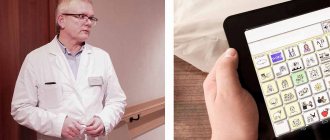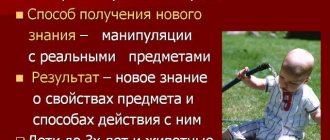In children, speech skills develop gradually until approximately 4 years of age. Some errors in speech are present in children of older preschool age. Over time, with proper communication between the people around them, mistakes in conversation and perception of texts in children disappear.
If a mature person does not understand the written text, can name only a few main words from the information read, does not express his thoughts well, and his speech lacks verbs, prepositions, and conjunctions, he should consult a doctor.
Perhaps the combination of these signs is an expression of a disease called agrammatism. There are several types of deviation. Correct diagnosis can only be made by a qualified doctor after a comprehensive examination.
What underlies the development of the disorder?
A person’s ability to comprehend and reproduce speech depends on a large number of factors:
- age;
- level of general development;
- education;
- communication environment;
- communication skills;
- psychological status;
- physical condition.
The onset of the disease can be triggered by anatomical features, organic changes in local areas of the brain, for example, the Sylvian fissure, the frontal or temporal cortex of the dominant hemisphere.
Normal pronunciation of words and syntactic structures is possible with the impeccable functioning of all nerve cells in the brain.
Total agrammatism in children can also cause impaired hearing during the development of speech. If sound waves are poorly perceived by auditory analyzers, the child hears poorly, and it is difficult, even impossible, for him to formulate sentences correctly.
Speech skills can only be developed through repeated full listening to verbal expressions and immersion in the audio environment of the language.
Emerging speech disorders in adults who already have developed sentence pronunciation skills cannot be explained by changes in the functioning of auditory analyzers. In such situations, there is a high probability of neurological disorders.
Agrammatism is characteristic of the conditions of alalia, aphasia, speech of people without hearing or with poor hearing, and children with developmental delays.
AGRAMMATISMS IN A CHILD'S SPEECH.
AGRAMMATISMS IN A CHILD'S SPEECH.
Speech therapist teacher: Natalya Andreevna Moreva
Good speech is the most important condition for the comprehensive development of children. The richer and more correct a child’s speech, the easier it is for him to express his thoughts, the wider his opportunities for understanding the surrounding reality, the more meaningful and fulfilling his relationships with peers and adults, the more active his mental development is. Therefore, it is so important to take care of the timely formation of children’s speech, its purity and correctness, preventing and correcting various violations, which are considered to be any deviations from the generally accepted norms of a given language.
By the age of approximately 3–5 years, children already master the basic grammatical aspects of speech, i.e., changing words according to cases, numbers, and persons. They have concepts about the seasons, parts of the day, and they have the ability to compose simple and complex sentences, including using conjunctions. Gradually, the grammatical side of speech improves even more. At this age, children can operate with different morphological means to construct the grammatical aspect of speech, complicating sentences with various constructions. However, the Russian language is rich in various grammatical rules and exceptions to them, which is difficult for a child to learn, so the grammatical side of a child’s speech consists of some grammatical errors. In the future, the child’s syntactic side of speech also improves. In younger schoolchildren, simple sentences also still predominate in their speech. In complex sentences they use particles “a”, “and”, “here”, especially when retelling fairy tales. Sentences with homogeneous members, tense and additional clauses are often used.
Causes of agrammatism in children.
Agrammatisms in children's speech are a natural phenomenon. They have their own dynamics, a dialectic of emergence and survival. They arise as a result of complexly organized work of the developing consciousness to generalize and analyze the facts of perceived and one’s own speech, active search activity, experimentation with words, and subsequently, elementary awareness of individual facts of grammar, which leads to the mastery of the grammatical structure of the language.
A child’s speech does not always develop well. Sometimes a child amazes us with frequent and persistent grammatical errors and has great difficulty mastering the grammatical structure of the language, which is accompanied by other shortcomings in the development of the child’s speech.
General speech underdevelopment is a variety of complex speech disorders in which children have impaired formation of all components of the speech system with normal hearing and intelligence.
The cause of general underdevelopment of speech can be various adverse effects, both in the prenatal period and during childbirth, as well as in the first years of the child’s life, which can lead to damage or underdevelopment of the child’s brain (infections or intoxication of the mother during pregnancy, toxicosis , birth trauma, asphyxia, incompatibility of the blood of mother and fetus by Rh factor or blood group, diseases of the central nervous system (neuroinfections) and brain injuries in the first years of a child’s life).
The occurrence of reversible forms of general speech underdevelopment may be associated with unfavorable environmental and educational conditions. Mental deprivation during the period of the most intensive formation of speech leads to a lag in its development. If the influence of these factors is combined with an organic deficiency of the nervous system or with a genetic predisposition, then speech development disorders become more persistent.
Despite the different nature of the defects, these children have typical manifestations indicating a systemic disorder of speech activity. One of the leading signs is the later onset of speech: the first words appear by 3-4, and sometimes by 5 years. Speech is ungrammatical and insufficiently phonetically designed. The most expressive indicator is the lag in expressive speech with a relatively good, at first glance, understanding of addressed speech. There is insufficient speech activity, which drops sharply with age, without special training. However, children are quite critical of their defect.
According to the severity of the manifestation of the defect, four levels of general speech underdevelopment are conventionally distinguished. The first three levels are highlighted and described in detail by R.E. Levina, the fourth level is presented in the works of T.B. Filicheva.
At the first level of speech development, children do not use morphological elements to convey grammatical relations. Their speech is dominated by root words, devoid of inflections. The “phrase” consists of babbling elements that consistently reproduce the situation they denote with the use of explanatory gestures. There is no or only a rudimentary understanding of the meaning of grammatical changes in words. Children are unable to distinguish between the singular and plural forms of nouns, the past tense of verbs, the masculine and feminine forms, and do not understand the meaning of prepositions.
At the second level of speech development, children show gross errors in the use of a number of grammatical structures:
1) incorrect use of case forms (driving a car instead of “by car”);
2) errors in the use of masculine and feminine nouns (de patya - “two briefcases”, de tui - two chairs);
3) lack of agreement of adjectives and numerals with nouns (pat bek, pat matyn - five squirrels, five cars; bsin adas - red pencil, bsin eta - red ribbon).
Children experience pronounced difficulties when using prepositional constructions: often prepositions are omitted altogether, and nouns are used in the nominative case (niga goes toy - the book lies on the table); it is possible to replace the preposition (hyp lyatet with dividim - a mushroom grows on a tree). Conjunctions and particles are used extremely rarely. The distinction and understanding of singular and plural forms of nouns and verbs (especially with stressed endings) is more developed. Forms of masculine and feminine past tense verbs. Difficulties remain in understanding the number forms and gender of adjectives. The meanings of prepositions differ only in a well-known situation. The assimilation of grammatical patterns largely relates to those words that early entered the active speech of children.
The third level of speech development is characterized by persistent errors when agreeing an adjective with a noun in gender and case (I needle the canopy - I play with a blue ball. I don’t have a blue ball - I don’t have a blue ball); confusion of gender of nouns (de veda – two buckets); errors in the agreement of the numeral with nouns of all three genders (two ruti - two hands, five hands - five hands, pat mided - five bears). Errors in the use of prepositions are also typical: their omission (I give it to my aunt - I am playing with my sister; Molasses is in my hand - the handkerchief is in the bag); replacement (the cube falls and melts - the cube falls off the table); non-statement (after climbing a girl, she climbed a tree, after climbing a girl, she went outside). Impressive agrammatism is also revealed, which manifests itself in insufficient understanding of the change in the meaning of words expressed by changing the prefix, suffix, etc.
At the fourth level of speech development in children, residual manifestations of lexico-grammatical underdevelopment of speech are not clearly expressed. There are errors in the use of genitive and accusative plural nouns and complex prepositions. In some cases, there are violations of the agreement of adjectives with nouns, when in one sentence there are masculine and feminine nouns (I color the ball with a red felt-tip pen and a red pen), singular and plural (on a large table, small chairs), violations persist in the agreement of numerals with nouns
In children with OHP, there is a violation of the syntactic structure of sentences, expressed in the omission of sentence parts, incorrect word order, and the absence of complex constructions.
Since lexical and grammatical constructions cause enormous difficulties for children with general speech underdevelopment, special attention should be paid to their formation.
At preschool age, children are capable of mastering the oral form of speech and therefore the grammar they master is the grammar of oral speech. In oral form, a child can use dialectisms and those forms that are consistently used by his family environment; this speech may lack various forms and constructions that sound reduced, for example, neuter endings “o”, “e” of nouns and verbs, endings “oe”, “ee” of adjectives. So, for example, the adjectives “kind, kind, kind” when pronounced by a child can have the same form (good).
The specificity of the development of grammatical structure in ontogenesis has limitations, which affects both the method of presenting the material and the nature of the presented material. In grammar, such phenomena as system and norm are distinguished. Systemic grammatical forms and constructions include those grammatical units, the construction of which is subject to certain rules, and the structure of these means is quite regular and frequent. Normative grammatical units include so-called exceptions to the rules, i.e. single forms that do not obey general rules in their formation. Many linguists, following L.V. Shcherba, distinguish between active grammar and passive grammar, i.e., grammar used in productive types of speech activity, and grammar used in receptive types of speech activity.
Preliminary ideas about the state of the child’s grammatical structure can be obtained during an examination of coherent speech. If we are dealing with a child who has the beginnings of phrasal speech, then the study of grammatical structures can be carried out in the process of manipulating toys. In this case, you can find out whether the child speaks a phrase, what is the length of this phrase and its structure. In addition, it is checked whether the child understands the simplest instructions to follow. It is useful to give the child provocative tasks, for example: “Take a cup. Place the cup under the chair,” “Take a small cube. Give the cube to mom. Take a big cube. Throw the cube on the floor,” etc. If the child has developed phrasal speech, then we can start with complex sentences that are accessible to children in structure, gradually moving on to simpler ones until we determine the level that the child confidently speaks.
The tasks can be given in a wide variety of ways: “Tell me what you see”, “Make a sentence with words”, “Answer my questions with a complete (expanded) answer”, etc. So that the child can demonstrate the most detailed sentences that he is capable of composing , it is necessary to maintain the atmosphere of the game during the examination of the grammatical structure, encouraging creative, detailed sentences. The communicative significance of the sentences compiled is of great importance. Therefore, it is allowed in the wording of instructions to include the addressee of the statement: “Tell me” or “Tell mom,” as well as a lively emotional response to the semantics of the received statement - laughter, questions about the content, disapproving shaking of the head, gestures of encouragement and approval, and for children with rough intellectual disabilities or young children - financial incentives in the form of sweets, cookies, beautiful pictures, pencils, etc.
To study the state of understanding phrasal speech, various types of tasks are traditionally used: performing multi-stage and single-stage instructions, including a more or less detailed set of data, matching pictures and sentences; reflected pronunciation of sentences of various structures, etc. The structure of the examination of syntactic skills, as a rule, includes special tests to study the state of coordination and control skills.
The connection of words according to the type of agreement includes those cases when the dependent word repeats all or several grammatical categories of the main word. For example, adjectives agree with nouns in gender, number and case, and present tense verbs agree with personal pronouns in number and person. You must be especially careful when presenting phrases with numerals. Thus, the numeral “one” is consistent with nouns, and the numerals “three” and “five” can only be used in the structure of phrases that have a different type of connection - control, since they require a certain case from the dependent word. When selecting language material, it is necessary to take into account the obviousness of grammatical features of the main words in phrases.
Formation of genitive case forms of nouns in singular and plural.
The speech therapist shows object pictures depicting different numbers of objects, and the child names them. Then the speech therapist removes the picture, which contains several objects, and gently encourages the child to say a word in the genitive plural:
1) ball – ball – balls;
2) window - windows - windows.
Agreement of adjectives with singular nouns in gender.
For example: the ball is blue; cup – blue; dress – blue.
Coordination of the numerals “two” and “five” with nouns: house, beetle, bucket, fish, ball, cherry, cucumber, apple, roof, boot, hat, watermelon.
Formation of nouns with diminutive suffixes. The speech therapist uses subject pictures with images of objects of different sizes:
1) table - little table - spoon - spoon;
2) window - little window - bed - crib.
Forming adjectives from nouns
The task is given: “Table made of wood. What table? and the speech therapist himself answers: “Wooden,” and then offers the child the following phrases: fur coat - (fur) paper cup - (paper), rubber ball - (rubber) glass jug - (glass).
To study the level of grammatical aspects of speech in early preschool age, words of the first type are predominantly selected, and for older children, words of the second and third types can be used, since children have a wider experience of communication, as a result of which normative grammatical units are mastered. However, if a child believes that the girl’s name is Lenya, this does not mean the presence of agrammatism, the child simply does not have friends with this name, and therefore he does not know its adequate way of using it. Only systemic regular errors, and not individual slips, can be used as material for making a conclusion about the state of the grammatical structure. The skill of coordination in independent speech can be studied in the process of manipulative or play activities of the child. For example: “What cube is this? What kind of pyramid is this? What cube are you missing? What ring should we use to finish the pyramid?” In the process of using specially selected pictures, “Look at the picture and say which one, which one, which one, which one?” The agreement of adjectives with nouns in cases is studied in preschool age only within the boundaries of the singular category. For this purpose, you can use substitution exercises (Agreements), as well as answers to questions.
When studying passive grammar, as a rule, picture material is used. These are a series of pictures that depict different objects that have the same color or objects that perform the same action. For example: blue pencil, blue book, blue bucket, blue cubes.
It is suggested to play a “Guessing Game”, but before that you need to practice your ability to guess what the speech therapist has planned. To do this, first the speech therapist clearly, at a somewhat slow pace, pronounces phrases one at a time, highlighting the endings in their orthographic form with his voice, and asks the child to listen carefully to the presented material. You can ask the child to pronounce these phrases reflectively. Thus, each of the phrases is repeated 3-4 times. Then the speech therapist asks the child to guess and show in the picture what he has in mind, and names the adjective or verb in the required form. To eliminate the chance of a coincidence in the children’s answers, each of the pictures is guessed 2-3 times in random order.
Children of senior preschool age who have minor deviations in the formation of the grammatical structure of speech are offered a more complex corrector-type task - listen to a phrase and correct errors, if any. In this case, some training is required for the child, during which he is taught to focus primarily on the sound indicators of grammatical categories, and then the material is read out for listening, clearly pronouncing the endings. In addition to coordination, as we have already mentioned, the state of management skill is examined. In phrases in which the connection is carried out according to the type of control, the main word requires a certain grammatical form from the dependent word. So, if the dependent word is expressed by a noun, then it must be in a certain case. There are non-prepositional and prepositional controls. In the second case, the connection is realized through the use of a preposition and a case ending. Therefore, sometimes such a connection is called prepositional-case control. As a rule, non-prepositional control turns out to be relatively simpler, therefore, the lower the level of speech development, the more problems will arise with prepositional-case constructions; the higher the level, the fewer agrammatisms we will notice in non-prepositional control. The state of prepositional control is revealed during the study of coherent speech and the level of development of the skill of constructing and formatting a sentence.
The examination is carried out with preschoolers in the form of a game. Linguistic material is selected in accordance with the age and speech capabilities of the subject, taking into account the ontogenetic patterns of formation of the inflection system. For children with a low level of development of the language system, the following material is offered: the accusative case of the object (I see a chair, I took the jacket), the instrumental case of tools (cutting with a knife, sawing with a saw), the genitive of absence (no dad, no chair), the dative of the addressee (give to the hare, show it to mom).
For preschool children, more varied material is offered, including the use of plural nouns in indirect cases. To study the understanding of prepositional control, it is useful to use tests to study the difficulties of understanding logical-grammatical structures proposed by A. R. Luria, but with the obligatory adaptation of speech material to the capabilities of preschoolers. Thus, a task to identify an understanding of the meaning of tools (show a pencil with a key, a key with a pencil, etc.) can be presented to preschoolers unchanged, but a test to identify an understanding of parental affiliation (brother’s father and father’s brother) is better replaced with something more accessible to a preschool child’s understanding, for example, where is the owner of the bicycle and where is the owner’s bicycle. Mastering prepositional-case control creates great difficulties for children with problems in speech development, since when mastering these constructions, certain prerequisites must be formed at both the nonverbal and verbal levels. However, in preschool age, as scientific literature shows, prepositions as independent words are not recognized by children without special training. The meaning of the entire prepositional-case construction is perceived as a single whole. Children with normal speech development intuitively recognize the presence of a certain preposition as a marker of a spatial situation, while children with systemic speech underdevelopment do not distinguish prepositions in their generalized phonemic form. For these preschoolers, two phrases: put the book on the table and put the book on the table - denote the same objective situation. Since when pronounced the preposition is reduced and does not sound explicit, the child interprets the instructions as absolutely identical. The study of active grammar, as a rule, is carried out on the material of spatial prepositions, conditionally divided into several groups, in accordance with the sequence of their formation in ontogenesis:
1) in, on, under;
2) with, from, over;
3) to, from, because of, from under;
4) behind, before, between, through, about.
The study of the state of prepositional control in young and middle-aged children is carried out during the process of playing or manipulating with objects, and the first two groups of prepositions are studied in more detail. When examining children of senior preschool age, the state of three groups of prepositions is studied. Pictures are used as the basis for the examination. But children entering school are already tested on the entire array of spatial prepositions.
It is very important to note that in some cases the same preposition, depending on its meaning, can be used with different case endings. For example, the preposition “in” in the meaning of the location of an object is combined with the prepositional case of the noun (in the table, in the box), and in the meaning of the direction of movement - with the accusative (in the table, in the box). Therefore, during the examination, children are asked questions: “Where is it?”, “Where did they put it?”, “Where did they get it from?” and so on. At the same time, attention is drawn not only to the adequate use of prepositions, but also to the correct use of case endings. If a child uses prepositional control correctly, then it is not necessary to examine the state of his understanding. But if he finds it difficult to use prepositional-case constructions, then it is necessary to study the state of receptive skills. And for this purpose, children are first offered those prepositions and those constructions with which the child experienced the greatest difficulty. For this purpose, modeling of a subject situation is used, in which the objects of manipulation remain unchanged, for example, a book and a pen. The child is asked to show when they say this: a pen on a book, a pen under a book, a pen above a book, a pen from a book, etc. In this case, it is necessary to minimize the hint in the form of a verb in order to check how much the child understands the meaning of prepositions. For children of senior preschool age, you can prepare a series of pictures that depict the same objects in different spatial relationships. In order to identify the level of development of the skill of understanding case constructions, children of senior preschool age are asked to perform a proofreading test, “calling for help” Dunno, Pinocchio or some other fairy-tale rogue. “Listen,” we say to the child, “did Dunno say correctly: “The book is on the closet”?” In order to make sure that the child has this construction in his passive grammar, it is enough to limit himself to the answers “right” - “wrong”, without requiring the child to pronounce the correct option. The same type of material should be presented to the child in different versions several times in order to avoid random coincidences. During the study of syntax, the speech therapist finds out the state of the inflection skill as a whole, noting the quantity and quality of agrammatisms in the child’s speech. However, it would be rational to specifically test the formation skills of certain grammatical forms in order to identify the state of the child’s language ability and the presence of primary speech impairment. When examining inflectional and word-formation skills, the speech therapist must exclude from the list of language material suppletive forms whose root parts do not coincide, for example: child - children, good - better, cow - calf. These forms belong to the examination of vocabulary, since they are memorized as ready-made units. An examination of the state of passive grammar is carried out in cases where the child demonstrates the impossibility of forming new forms or words during the examination of active grammar. As an ongoing monitoring of the process of understanding word-formation forms and constructions, you can ask the child to explain when they say so, or to compose a sentence (word combination) with a given word. For example, “when can you say “eyes”, and when is it better to say “eyes”, “make up phrases with the words “bear” and “bear cub”.
If a child has severe underdevelopment of speech, the range of grammatical means in active grammar is sharply limited, therefore, when examining these children, it is rational to use special didactic material designed to test the understanding of the simplest grammatical categories: number, gender, tense, some case forms and constructions. Instructions like “Show where (in which picture) the pencil is and where the pencils are” are used, “Show in which picture they are running and in which one they are running”, “Give me the cubes. Give me a cube,” etc. During the study of the lexical and grammatical aspects of speech, it is recommended to keep an examination protocol, where data on the presented material is entered, about what material the child can cope with and what not, errors are recorded, and a score is assigned.
Assessment of the level of grammatical aspects of speech is carried out according to indicators of grammatical structure:
1) type of sentence: absent, nominative, simple non-extended, simple common, complex, complex, with homogeneous members, complicated by participial and adverbial phrases;
2) various types of proposals are used adequately to the plan;
3) the breadth of the sentence (average length);
4) the degree of severity of agrammatism, if present: absence of grammatical forms, rudiments of grammatical design, use of individual grammatical forms (which ones?), gross agrammatism, non-coarse agrammatism, individual agrammatisms (which ones?), unstable errors;
5) level of manifestation of agrammatism: inflection, word formation, syntax;
6) the nature of agrammatism: lack of grammatical means, confusion of models, hypergeneralization, violation of word order in a sentence, omissions (substitutions, confusion) of prepositions, etc.
After completing all tasks aimed at identifying the level of grammatical aspects of speech in a child, a total score is calculated. The highest score is 50 points, which corresponds to a high level. 30–40 points is an average level of development, and a low level is a total score of less than 30 points.
SOME TECHNIQUES TO WORK TO OVERCOME
AGRAMMATISMS IN CHILDREN'S SPEECH
Using didactic games and exercises to form the lexical and grammatical structure of speech.
The grammatical structure of speech is formed in everyday communication and in various types of children's activities - in play, design, and visual arts. And an important pedagogical condition is the competent organization of this activity by adults in everyday life.
The most important type of children's activity is play. The advantage of game methods and teaching techniques is that they arouse increased interest and positive emotions in children, and help to concentrate attention on the learning task, which becomes not imposed from the outside, but a desired personal goal. Solving a learning task during a game involves less expenditure of nervous energy and minimal volitional efforts.
A special group of games are didactic games. The main goal of any didactic game is learning. Therefore, the leading component in it is a didactic task, which is hidden from the child through play. The originality of a didactic game is determined by the rational combination of two tasks: gaming and didactic. If the educational task predominates, then the game turns into an exercise, and if the task is a game, then the activity loses its educational value.
When working with preschoolers of primary and middle age, all games are played using toys, real objects and their images.
Special games and exercises have been developed that are designed to teach children how to change words correctly and help them remember difficult forms of words necessary for everyday communication. These are well-known games: “What’s missing?”, What is Misha missing for a walk?” (for the formation of genitive plural forms of nouns); “Wonderful bag”, “Multi-colored chest” (for mastering the gender of nouns); “Orders”, “Do you want? - We want” (for verb conjugation); “Hide and Seek”, “What Has Changed?” (for the assimilation and activation of prepositions and adverbs), etc. It should be emphasized that in the game the child is not aware of its true purpose. He sees and understands the task of the game: to be attentive, remember how objects stood, recognize a toy by description, etc. In games and exercises, a child acquires grammatical knowledge and skills, as if outside of consciousness. At a younger age, in addition to didactic games for the formation of the grammatical structure of speech, one should use dramatization games that do not have a narrow didactic focus, but a broad general developmental effect.
With children of senior preschool age, board-printed games are used, in which children learn and consolidate knowledge in practical actions not with objects, but with images in pictures. Such games include: lotto, dominoes, paired pictures.
A special role in the speech development of children of senior preschool age is assigned to verbal didactic games (without visual material). In verbal didactic play, children learn to think about things that they do not directly perceive and with which they are not currently acting. This game teaches you to rely on the idea of previously perceived objects in solving a problem.
You can use the following games and exercises with grammatical content: “One-many” (formation of the plural of nouns in the nominative and genitive cases), “Which, which, which?”, “Correct the mistake,” “Blurred letter” (word agreement in a phrase and sentences), “Good is better” (formation of degrees of comparison of adjectives and adverbs), “Say the other way around” (formation of antonyms), “Whose tail? Whose paw? (formation of possessive adjectives), etc.
The element of competition in games in older preschool age increases children's interest in completing tasks and ensures better assimilation of program material, helps children complete tasks clearly and correctly, without making mistakes.
The use of such didactic games and exercises makes it possible to successfully solve the issues of developing the grammatical structure of speech.
I wish you success!
Manifestations of agrammatism
Examples of agrammatisms
It is easier for a person with this disease to understand unambiguous sentences. For example, the phrase “I bought bread” will be understood more easily than the sentence “I am listening to you.” In the second case, unlike the first, the reverse action option “Are you listening to me” is possible.
Short phrases with the classic word order “It’s raining outside” are easier to understand, as opposed to a larger sentence with clarifications “It’s raining incessantly outside again.”
A sick person does not communicate quite competently from a literary point of view. Everyday speech structures differ significantly from correctly constructed sentences. The ability to perceive ordinary speech in people with agrammatism is significantly reduced.
Symptoms can be identified by a specialist through attentive communication, demonstration of visual materials, accompanied by a request to describe them, talk about them. If a person is sick, his speech consists of the simplest sentences, with a minimum of words, often pronounced slowly.
Diagnostics
Identification of agrammatisms in writing and in oral expression is carried out by a speech therapist-defectologist during a pedagogical examination. To assess the condition of the HMF, a consultation with a neuropsychologist is required. The general diagnostic plan consists of the following stages:
- Diagnostics of oral speech.
Primary attention is paid to examination of vocabulary and grammar. Vocabulary, skills of forming words using prefixes and suffixes, changing words by numbers, gender, and cases are explored. Tasks are given to retell the text, compose a story based on a plot picture and a series of pictures. A comprehensive examination allows us to identify morphological agrammatisms. - Diagnostics of written speech.
Students are taught written work. Students are asked to make sentences using pictures and supporting words, and write a summary. When performing written tasks, as a rule, syntactic and semantic agrammatisms are detected. - Examination for aphasia.
In patients with aphasic disorders, the understanding of speech (questions, instructions) and the ability to speak (automated, repeated, spontaneous speech, naming objects, composing stories) are examined. The ability to write and read is analyzed. The examination may reveal expressive or impressive agrammatism. - Neuropsychological diagnostics.
Within the framework of the neuropsychological approach, an individual’s ability to program, regulate and control a speech act, as well as the peculiarities of processing auditory-verbal and visual-spatial information, are assessed. In the presence of agrammatisms, neurodynamic disorders involved in the organization of speech activity are identified.
Correction of agrammatism
Forms of violation
Experts distinguish two main forms of agrammatism:
- Impressive is characterized by a lack of understanding of speech in whole or in part. The root adjective in the title means “perception” in English. Changes in the functioning of brain cells do not allow the sound signal to transform into thoughts and images.
- Expressive disorders are identified when it is impossible to use prepositions, declensions, and cases in speech; when spoken sentences are formed incorrectly or incompletely. The root of the adjective in this title means "expression" in English. Problems with the functioning of the local area of the brain prevent the transformation of thoughts into speech phrases. Depending on the location of the problem area, the resulting speech anomaly (aphasia) may be sensory or motor in nature.
Sensory changes are caused by a violation of the ability to feel and perceive a sound signal.
Motor disorders in Broca's center cause difficulties in controlling the muscles of the larynx, tongue, and jaws, which do not allow speech to be reproduced well. Often the patient can only pronounce basic words.
His speech resembles the text of a telegraph message, in which nouns predominate or, conversely, only verbs are present. Such specific features make it possible to clarify the localization of the brain area with impaired activity.
Correction
Speech therapy classes should begin in parallel with medical measures or immediately after them. Thus, assistance to hearing-impaired children, first of all, should include rational hearing aids and classes with an audiologist. In case of acute stroke resulting in aphasia, comprehensive drug, neuropsychological, physical and speech rehabilitation is required. With tachylalia, a favorable background for speech therapy correction is achieved with the help of physiotherapy, hydrotherapy, and a course of massage. The tactics of speech therapy are determined taking into account the leading syndrome.
Improving grammatical structure
To form the grammatical structure of a language, it is necessary to communicate a lot with the child from early childhood, read high-quality children's literature, and surround him with worthy speech examples to follow. You should not repeat the child’s agrammatisms; you must immediately correct the mistakes made by pronouncing the correct pattern. Grammar games are useful for speech development, helping to automate normative variants of word formation (“One-many”, “Big-small”, “What is missing”, etc.).
OHP correction
Corrective education for children with special needs development disorders is carried out in specialized speech therapy groups of preschool educational institutions, starting from the age of 4. Agrammatism must be overcome by the start of school. In classes, a speech therapist clarifies and expands children's vocabulary, develops understanding of speech, develops skills in inflection, word formation, and the use of simple common and complex sentences. As lexical and grammatical means improve, coherent speech develops, the ability to compose a story and retell what is heard is formed.
At the same time, phonetic gaps, phonemic underdevelopment, and violations of syllabic structure are eliminated. The preparatory group works on developing basic reading and writing skills. During classes they use physical education exercises, articulation gymnastics, phonetic rhythms, exercises for the development of fine motor skills, and, if indicated, speech therapy massage.
Dysgraphia correction
Since written agrammatisms are a consequence of general speech underdevelopment, their correction is carried out in the same basic directions. Additional attention in classes is paid to the study of the morphological composition of words and the syntactic structure of sentences. The consolidation of grammatical norms and rules is carried out not only in oral, but also in written exercises.
Rehabilitation work for aphasia
Different types of aphasic disorders require a differentiated approach to speech rehabilitation. To eliminate impressive agrammatism in semantic aphasia, work is being done to overcome disturbances in spatial perception and restore understanding of logical-grammatical structures. With sensory aphasia, the patient is taught to understand situational speech, differentiate phonemes, and formulate phrases grammatically correctly.
After disinhibition of oral speech, patients with motor aphasia move on to developing correct articulatory postures and switches, overcoming grammatical distortions (composing detailed sentences, correct use of prepositions and conjunctions, etc.), restoring reading and writing.
The main task for dynamic aphasia is to stimulate speech activity, train in word inflection, and construct phrases of various syntactic models. In order to overcome agrammatism in patients with acoustic-mnestic aphasia, work is being done to expand auditory-speech memory and compose complex sentences.
Establishing diagnosis
Correct diagnosis is the result of comprehensive observation and examination. It is very important to determine:
- general condition of a person,
- his psychological and neurological status.
During communication, the specialist evaluates:
- rate of speech;
- variety of syntactic forms used;
- correct use of cases and declensions in speech;
- the presence of unions;
- the presence of prepositions in dialogue and monologue when describing a visual object.
When testing, the number of words and syllables in spoken sentences and the consistency of the endings used are assessed.
To identify disorders of brain activity, it is recommended to do an encephalogram, ultrasound or tomography.
Summarizing and analyzing the information received, the specialist makes a decision to establish a diagnosis.
What is agrammatism? What is paragrammatism? What is dysgrammatism?
Agrammatism is a violation of the ability to use grammatical
structure of speech. The term agrammatism comes from the Greek prefix “a”, meaning absence of a characteristic or quality, and the Greek word grammata, meaning writing, reading. Synonyms for agrammatism are paragrammatism , disgrammatism . Some patients incorrectly call this disease agramatism .
Treatment methods
Agrammatism is a neurological disorder that requires the help of qualified specialized doctors. Medical treatment, depending on the age and severity of the patient’s condition, may include a course of medication, reflexology, physiotherapeutic procedures, and hypnosis.
Correcting the condition with medications can significantly improve the blood circulation of brain cells and make them function more efficiently.
Impact on active points during reflexology can be carried out using different methods:
- mechanically;
- thermally;
- electrical discharge;
- laser beams;
- electromagnetic waves;
- pharmaceuticals;
- implantation of foreign elements;
- combining techniques.
Author's techniques, tested by many years of experience? differ in the choice of sensitive points on the patient’s body and methods of acting on them.
Positive changes are observed during physiotherapy for expressive agrammatism. For sensory problems, the correct choice of physiotherapeutic methods helps to improve the patient’s perception of sounds.
The influence of motor anomalies is minimized by restoring the activity of the muscles of the larynx, jaw, and tongue.
Agrammatism, like other neuropsychological disorders, can be corrected by professional hypnosis, which improves the quality of spoken speech.
The treatment algorithm is selected by specialists individually. In addition to medical care, the patient will need the help of psychologists, speech therapists, and teachers during the recovery period.
Forecast
It is necessary to treat and eliminate agrammatism. Only in this case is it possible to improve a person’s ability to use human speech and establish contacts with others. The treatment prognosis is positive, as it allows you to restore speech skills. The result of the lack of treatment is detachment from society, which will not accept the person.
From birth, parents should take an interest in their child's health. There is no need to rush or worry about speech delays as all children develop at their own pace. However, if speech has not recovered by the age of 4, you should consult a doctor.
A person must constantly visit a doctor and register with him. This will allow you to adjust treatment depending on the development and course of the disease. Qualified doctors work with a child or an adult. However, help from loved ones is needed here. They should conduct exercises and monitor changes in the patient’s speech.
It is almost impossible to prevent agrammatism. However, sometimes it is acquired due to the unfavorable environment in which a person finds himself. If parents do not work with the child, do not communicate with him, do not teach him speech, then acquired changes are quite possible, which can be easily corrected together with a speech therapist.
You can anticipate trouble
To prevent the appearance of agrammatism, the normal neonatal period of the child’s formation is very important.
Neurological disorders of the unborn child can develop during a difficult pregnancy, aggravated by infectious or other diseases. A correct lifestyle and regular observation by an attentive doctor of the expectant mother is the key to the birth of a healthy baby.
Abnormalities in the functioning of brain cells can appear in adults due to past illnesses and circulatory disorders. A preventive measure is a careful attitude to one’s own state of health, the use of general strengthening procedures in everyday practice, and the formation of healthy lifestyle habits.
The condition of patients with agrammatism can be significantly improved, up to complete recovery. Successful treatment is possible with timely consultation with specialists and strict adherence to the doctor’s recommendations.







